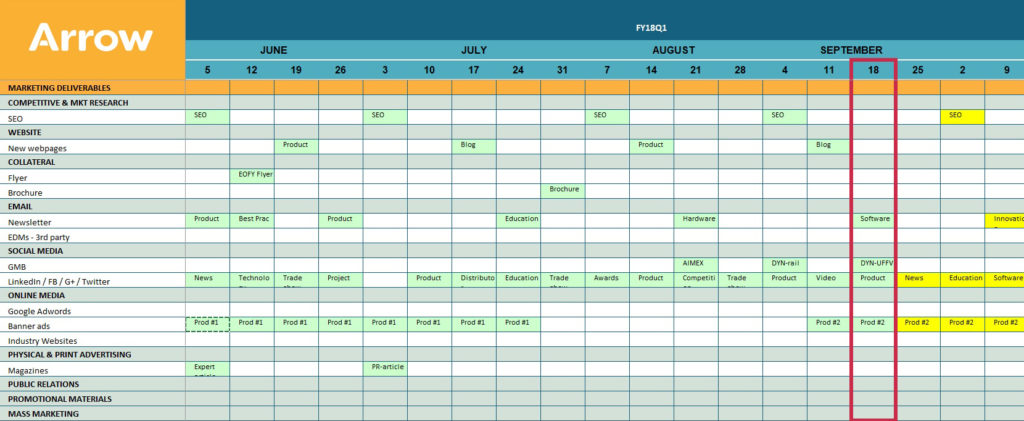It is easy to suggest ways of promoting your business through social media marketing: create blog articles, e-books, updates and photos, comments, white-papers, infographics, audio content, ‘how-to’ videos, customer reviews… It would also be very easy to drain your resources into a ‘black hole’. So how do you focus? And how can B2B marketing with social media be done really effectively?
This article is a quick reference guide for defining:
- What you are doing on social
- Who you are talking to
- Where you should invest your time and money
- What you are going to say
- Which behaviours lead to accelerated results
- What content strategy can deliver value to your audience
- How to go about measuring your progress
B2B social media marketing – steps to success
What you are doing on social
Your strategy on social. If you are going to be there, and we think that all modern businesses should, then decide on your purpose at the beginning. You can:
- Listen. Create a profile, sit there, and listen to what people say about your brand, your products and your competitors. You can ‘listen’ to people discussing their perceptions on a product, the decision to make a purchase, or even switching brands. Social listening is a valid strategy. It is low-burden, and provides actionable insights that can help improve your business.
- Focus on content marketing. Invest in building new content and deliver real value to the audience that has decided to seek you out.
- Boost! Extend your reach with advertising. Invest to increase your audience, generate leads from specific offers, or make money from direct-response sales.
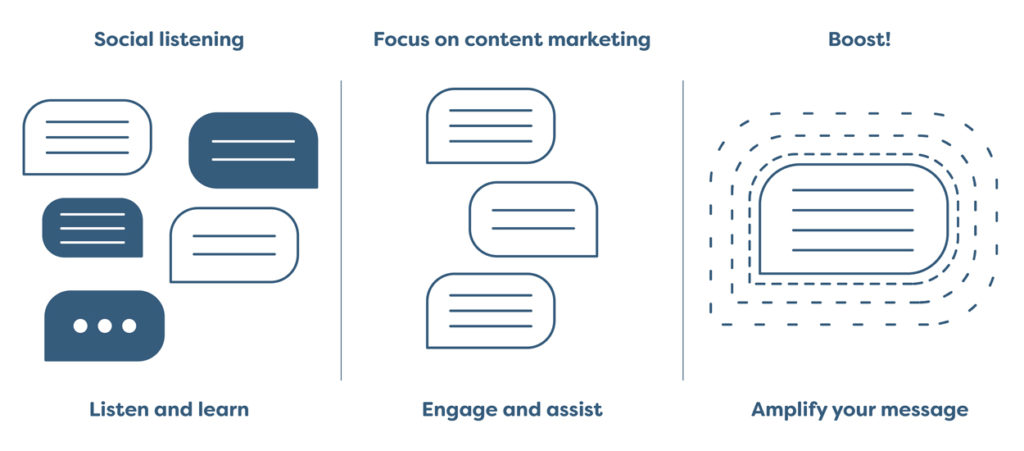
Who you are talking to
Personas matter. Did you expect to rock on in there and talk to everybody? There are certain people in certain places who will care about your kind of stuff. You should be talking directly to them.
If you intend to create or share content on social media, then you should have the specific customer you are trying to engage, in your mind. It will affect what subjects you cover, the type of content you share, the way you position it, and the language you use.
If you need a digital marketing agency in Newcastle to help you develop customer personas, or to work on value-proposition design, then please give us a call.
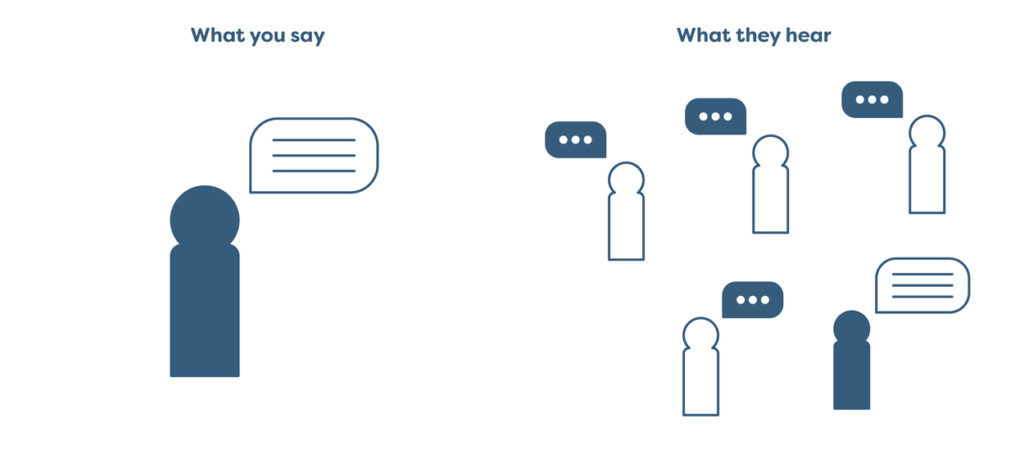
Where you should invest your time and money
Choose the right social media platforms for your business. Unless you have a large budget for administering social profiles and creating content, we recommend keeping it simple. Just start with a couple of profiles on the websites most likely to connect you with your target-audience. Our article on which platforms are best for B2B social media marketing compares popular social websites to traditional sales/marketing tools. It also covers the benefits of each social media platform discussed, including advertising options, so that you can make an informed choice.
Time is money. People often overlook the effort that goes into monitoring social platforms, posting updates, responding to comments, and crafting the content itself. If you intend that on a weekly basis your team will find and share relevant content, or grab a photo of something going on in your business and draft text to go with it; then you will probably be investing 2-3 hours per week. If your team are creating specific pieces of high-value content, or posting updates at a higher cadence, then the time and money being invested is multiplied. If you want to amplify your reach with a few advertising dollars then multiply it again.
Social media marketing is definitely, one of the most cost-efficient ways to demonstrate expertise to your target audience, and stay connected with them as well. That said, you’ll feel a whole lot better about it if you budget appropriately, as part of your annual planning.
One final point on investing resources efficiently: there are a multitude of CRM, marketing automation, and social reporting suites available to save you time. If your business transmits messages on more than two social media platforms, then for $50 per month or less, your team can publish to all your social profiles simultaneously. Furthermore, ‘pre-posting’ updates for a week, or a month can be done at the same time. The actual posts are scheduled to go live at the most appropriate date and time. This kind of software dramatically increases the efficiency of your team, and also improves the level of interaction you achieve from your posts.

What you are going to say
What should we say? Content is king, and you’re a publisher now. Tell them something they don’t already know. Learn what subjects they interact with over time, and provide more of the content your audience wishes to consume.
As a general rule; industry news, especially positive industry news, will be read. Pictures of your team demonstrating what they do will work better. Posts celebrating people and events and nostalgia will work best. Intersperse this with educational pieces of content plus some semi-regular product positioning and you’ll be on the right track.
We strongly suggest you come up with most of your content ideas in advance. Put them into a marketing calendar, and chip away at them as the weeks go by. As people make more suggestions, add them to a reserve list. Intersperse these with ‘right now’ updates by discussing news in your team meetings: What’s new? Have we won anything? Are we going anywhere? Do we have a great distributor? Are we delighted to be supplying a new product? Can we celebrate an achievement?
And finally, if you’re not already, make sure that everything you post has a photo, gif, video, or something else to look at. Ideally this visual is something new or useful, but the engagement rates compared with text-only content are so much higher, that including visual content should just be the rule.

Which behaviours lead to accelerated results
Consistency is the key to success. Many potential customers need to see your brand at least a dozen times, and over a year or more, before they will act. If people are not engaged by your content, then social media platforms will automatically show them other posts that do interest them instead. The way that you achieve consistency with social media marketing is by laying out that great big list of subjects you came up with, into your marketing calendar. Prepare the content and text in advance of when it is needed, and send it out at a regular cadence, like clockwork.
Boost it! People are unlikely to find your social media content by accident. For a modest amount of money, your best content can be promoted, to help introduce your brand to new audiences, and to invite back those people who haven’t seen you in their feed for a while. This will increase your followers over time, welcoming more new prospects to the top of your sales funnel. In terms of consistency, a highly-targeted niche with a small regular advertising budget will provide better results than a large ‘single-campaign’ budget, or a broader audience. For regularly boosting posts, $50 per week paid to Facebook or LinkedIn should have a very significant impact on your audience development.

What content strategy can deliver value to your audience
Big Rock, Little Rock. We’ve covered that the consistency of your posting is important, and that actually having new content is king. The most efficient way, in our opinion, of creating consistently-great content is to use the ‘Big Rock, Little Rock’ approach.
Basically, this means putting your time and money into creating something really, really useful, and then re-using the hell out of it in different ways (while you get to work on your next Big Rock).
Depending on the factors above (your social media strategy, your audience, your key messages), a ‘Big Rock’ could be a detailed product catalogue, a how-to guide with checklists, an in-depth case study, a video presentation, an industry snapshot report, a collection of articles made into a reference document… This item should represent the best of your brand, but it must also be USEFUL to the reader.
Once prepared, you can slice this up into your ‘Little Rocks’: images, infographics, short articles, Top 5s, video snippets, adverts, quotes… you get the idea! You can then post these ‘Little Rocks’ across your social media channels.
Don’t be afraid to publish the same piece of content, on multiple social media websites. You’ll find that your target audience will have their preferred channels, so to reach them you’ll need to spread out. It will also help your brand come across consistently.
One Big Rock can provide the backbone, for an array of high-quality and affordable content on your website and social media platforms, for perhaps six months. Now that; is an efficient and impactful use of the marketing investment!
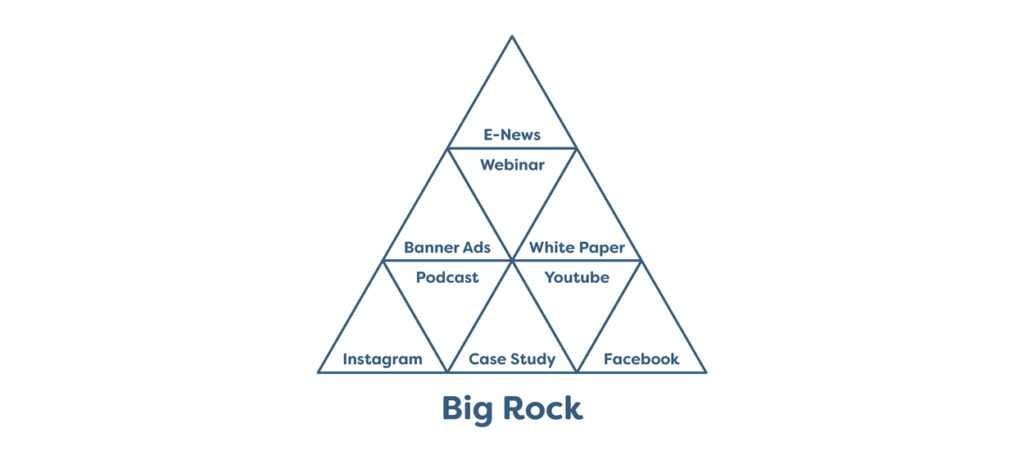
How to go about measuring your progress
This isn’t the 90’s; you can measure your results! One thing we love about social media marketing is that you can tell, in absolute terms, what happened after the dollars went in. If you are seeking to develop an audience, you can see which content is working. If you are experimenting with regular content delivery, then you can monitor the effect on engagement rates.
When your organisation moves from sporadic use of social to a structured marketing calendar, the increase in reach should be evident. Possibly most exciting; if you are trying to sell online, you can measure the number of individuals who see your ads, interact with each one, go to your website, and make an actual purchase. The days of putting marketing dollars in, and then having absolutely no idea what happened, are over.
If you’re not sure where to find this magic data, and you aren’t using a social media reporting package, then the following pointers will get you started. In Facebook; go to the insights tab and export your page and post data for a specific (completed) month. You can now track your month-on-month results. In LinkedIn; the analytics tab can summarise metrics on your visitors, updates, and followers. We suggest you view and track it, on a monthly basis once again.
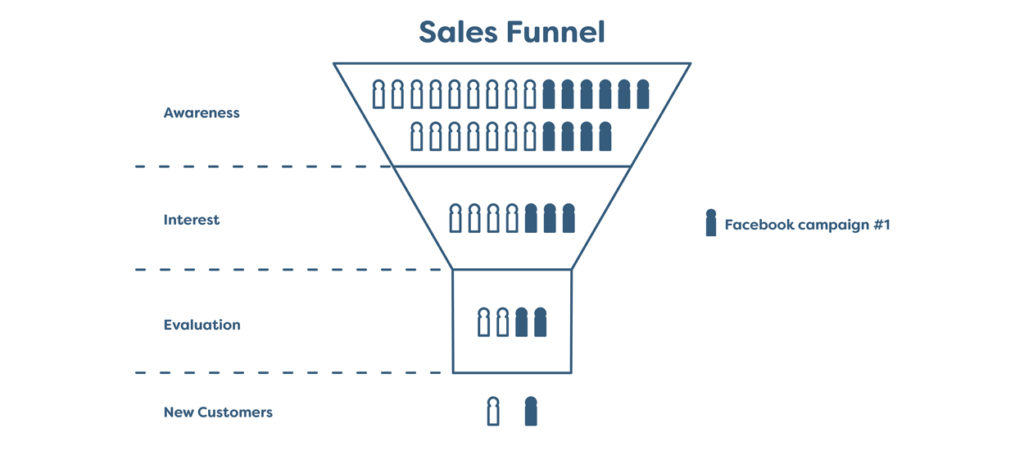
Of all the points above, if we were to give you one tip from Arrow on B2B marketing with social media, it would be to use a Marketing Calendar. If you have a plan, and act systematically, then you are much more likely to be efficient and successful.
To get you started, why not download our free Marketing Calendar Template.
If you would like advice on planning a marketing calendar, or on B2B social media marketing in general, please contact us.
If you’d like to continue reading about social media marketing with Arrow, take a look out our social media services page, or our blog on which platforms are best for B2B social media marketing.
